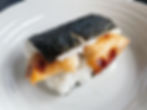Tokyo's Best Onigiri: Two Top Shops
- Marion P.
- Aug 28
- 7 min read
Updated: Nov 22
Onigiri, or rice balls, in English, are the quintessential Japanese snack: you’ll find them in every convenience store, tucked into bento boxes, and packed for picnics and day trips. While onigiri is often linked to convenience stores, there are specialist shops called onigiriya (おにぎり屋 ) dedicated to making hand-shaped rice balls. These are the places to discover just how great onigiri can be. In this blog, we will introduce you to two shops where you can find Tokyo's best onigiri.
What Are Onigiri?

Onigiri (also called omusubi) are rice balls filled with savory ingredients, and meant to be eaten as a quick meal, often on the go. Think of them as somewhat of a Japanese version of the sandwich.

The iconic onigiri you may be familiar with is a neat triangle of rice wrapped in nori, but you’ll also spot round shaped onigiri as well. Fillings range from grilled salmon to umeboshi (pickled plum), mentaiko, kombu, and tuna mayo. But, as you will see the sky is the limit for what you can fill onigiri with!
Onigiri's 2000 Year History
Onigiri being a very simple meal, has origins that are quite difficult to trace. The first onigiri-like meals found by archeologists in Japan are around 2000 years old. At the time, they were cone-shaped and wrapped in bamboo leaves.

During the Heian period (794-1185), rice balls were called tonjiki and were egg-shaped. Onigiri were typically given to servants and officials during events. Around the sixteenth century, they started being used as rations for the troops as well. Back then, umeboshi (pickled plums) were already a popular filling thanks to their antibacterial properties.

Around the mid 1880s, onigiri began to be wrapped in nori seaweed instead of bamboo leaves and became a popular meal across the country, especially for picnics and travels. The very first ekiben (station bento box), created around that time, was onigiri!
Onigiri's Evolution (Why Konbini Matter)
The next big onigiri innovation came from convenience stores in the 1970s, when they invented a special plastic packaging that separated the nori seaweed from the rice to keep the onigiri cripsy and fresh. They also sold new fillings inspired by western cuisine like tuna mayonnaise.

In 1991, the popular manga Cooking Papa created a brand new onigiri that took Japan by storm. This version, called onigirirazu, is a larger onigiri shaped like a sandwich. Thanks to social media, onigirazu exploded in popularity in the 2010s thanks to social media. In 2015, it even got awards from the Japanese websites Cookpad and Gurunavi.

Nowadays, Japanese convenience stores are constantly innovating, creating new original fillings for onigiri. One recent example being Akuma no Onigiri (Devil's onigiri), made of seasoned rice mixed with cripsy tempura bits.

This onigiri became so popular that it sold hundreds of thousands of units within the first month and copycat recipes multiplied on the internet, including in English.
Onigiri Asakusa Yadoroku: Tokyo's Oldest Onigiri Shop
You'll find Onigiri Asakusa Yadoroku a short walk away from the Senso-Ji temple in Tokyo's famous Asakusa neighborhood. This onigiri shop was founded in the 1950s and has a cosy atmosphere with just a counter and a few small tables. The chef chats joyfully with his regulars while making the onigiri fresh from the rice cooker.

There are 18 kinds of onigiri to chose from. I chose classic flavors: grilled salmon and salmon roe. A few minutes after I ordered, the chef brought me the onigiri in a bowl made of woven bamboo, which reinforced the shop's traditional feel.
What to Order at Onigiri Asakusa Yadoroku: My Review
Eating freshly-handmade onigiri from an onigiri shop is completely different experience than picking up a premade version from the convenience store.

This onigiri was, for the lack of a better word, perfect. And I understand why this onigiri shop is considered one of Tokyo's best. The nori was crispy and the lightly salted rice was still warm and fluffy, not too pressed like onigiri made using molds or machines. The filling was generous as well, with big pieces of flaky, salty, grilled salmon and a generous serving of salmon roe.

I decided to try a vegetarian option as well: vegetables pickled in soy sauce. I didn't expect anything from it, but I was pleasantly surprised by the contrast created by the crunchy, savory vegetables and fluffy rice. I would have eaten a second vegetarian onigiri without hesitation!

When I heard that this was the oldest onigiri shop in Tokyo and that it had received a Michelin Bib Gourmand, I was worried about it being too touristy. However, it was nothing like that. The shop had a relaxed atmosphere filled with regular customers which is always a good sign. If you're looking for a satisfying and simple traditional Japanese meal or snack in Asakusa, this is definitely the place to try.
Onigiri Bongo: The Best Onigiri In Tokyo
Founded in 1960, Onigiri Bongo is one of Tokyo's most popular onigiri spots located next to Otsuka Station, near Ikebukuro on the Yamanote Line. Due to its popularity and reputation as one of the best – if not the best – onigiri in Tokyo, the staff is used to the constant queue forming in front of their restaurant that they will not only give you the menu but also offer you a cup of green tea and an umbrella while waiting.

Their menu is the first surprise: not only do they have over 50 choices of onigiri fillings, from the traditional grilled salmon to experimental peanut miso, cheese, and kimchi, you can add up to two fillings per onigiri creating an infinite number of combinations!

My mind raced as a looked at the menu, deciding which two toppings to fill each of my onigiri with and almost ordered way more than I could eat. Fortunately, the staff had told me that four of their onigiri would be too much for one person, since their rice balls were larger than average.
Top 10 Most Popular Onigiri Flavor Combos at Onigiri Bongo
The restaurant features a ranking of the most popular flavor combinations. It's only in Japanese so here's a translation to help:

1. Salmon roe + Salmon
2. Soy cured egg yolk + minced pork
3. Pork kimchi + natto (fermented soybeans)
4. Soy ginger tuna + chili pepper
5. Bacon + Cheese
6. Clam salad + grilled pollock roe
7. Shiso kelp + mentaiko (pollock roe cured with red chili peppers) mayonnaise
8. Mountain burdock root + Shiso
9. Beef tendon + Curry
10. Mentaiko + Takana (mustard leaf)
But, even if you don't choose from these top ten, you really can't go wrong with any filling combination at Onigiri Bongo.
Planning a food-focused trip to Tokyo? Japan Food Travels creates personalized itineraries built around the flavors you care about most - from onigiri institutions to hidden neighborhood snack shops.
My Review of Onigiri Bongo: Why it is Tokyo's Best Onigiri
Choosing only three onigiri was tough, so I skipped the second topping this time and went with a soy-cured egg yolk (my go-to), pickled wasabi in sake lees, and negitoro (fatty tuna with green onion). Seating is a single counter around the kitchen, ideal for solo diners or pairs, while larger groups can easily order to-go.

As a huge fan of wasabi, I had to start with the wasabi-zuke, wasabi pickled in sake lees. The flavor was far bolder and spicier than the typical wasabi dabbed on sushi and it was rounded out nicely with the sake lees.

The onigiri themselves are quite big, and the rice is warm, so you are given chopsticks in case the onigiri falls apart in your plate. I tried the negitoro next and the minced fatty tuna mixed with green onion was silky, rich and melted in my mouth.

I ended my meal with the onigiri I anticipated the most: soy cured egg yolk. This flavor is actually my default choice of konbini onigiri, so I was excited to try one from an onigiri shop.

It exceeded my expectations. While konbini onigiri may have half of an egg yolk inside, this one had egg yolk oozing from the onigiri and a piece of cured egg yolk on top! It was extremely creamy, savory, and the perfect way to end my meal.

I left Onigiri Bongo wanting to come right back. From the sheer variety of flavors to the quality and generosity of the onigiri, they deserve their reputation as the best onigiri in Tokyo. Another sign of Bongo's popularity - the bookshop across the street is filled with posters advertising the shop, along with the shop's books (a recipe book and one about the shop itself) and onigiri-themed goodies.
Final Thoughts
Onigiri has always been one of my favorite Japanese foods and I even make my own salmon onigiri at home from time to time. But visiting specialty shops opened up a new world of deliciousness and creativity.

While konbini onigiri is a rite of passage for your first visit to Japan, I recommend going to these onigiriya to experience the true potential of Tokyo's best onigiri.
Want to Experience Onigiri like a Local?
Join our small-group Tokyo Street Food Tour in Togoshi Ginza and eat your way through Tokyo's longest shopping street. You’ll sample onigiri and other iconic Japanese street foods like curry bread, yakitori, gyoza, and more!
Book here: Tokyo Street Food Tour - Togoshi Ginza




